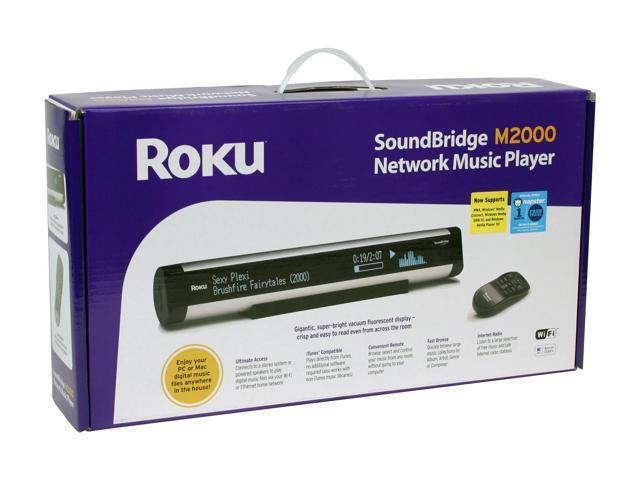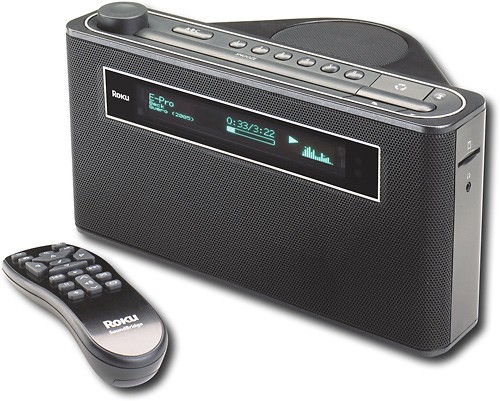Hi-Fi Hall of Fame
2024 Inductee
Roku SoundBridge
Network Music Player

Introduction
The Roku SoundBridge Network Music Player is our next nominee for induction. The SoundBridge was a simple looking, inexpensive device from a new (at the time) company. What makes the SoundBridge worthy of consideration is that it was was one of the world’s first network audio streamers.
The SoundBridge was a standalone Hi-Fi component, similar to a turntable or a cassette deck, which meant that the SoundBridge could be easily added to an existing audio system. For the first time, users could stream music from a digital source to their speakers or headphones.
The SoundBridge was capable of streaming from a variety of sources. Subscribers to online music services such as iTunes or Rhapsody could stream music from those sources. Users could also stream music from their own personal music library, after installing suitable server software on their home computer. You could also listen to a wide range of Internet radio stations without the need to power on a computer, including Roku’s own “Roku Radio” service.
The elegantly designed SoundBridge was housed in an attractive aluminum enclosure to fit in aesthetically with a Hi-Fi system, and it included a wireless remote control for ease of use.
Today, we take all of these capabilities for granted, but the Roku SoundBridge was one of the first network streamers to incorporate all of these elements. Let’s have a look at this remarkable machine.

Key Facts
| Manufacturer | Roku |
| Model | M1000 SoundBridge |
| Category | Network Streamer |
| Years in Production | 2003 – 2008 |
| Hi-Fi Hall of Fame Induction | January 2024 |
| Link to Nakamichi website | Roku.com |
Roku SoundBridge Technology
The first two SoundBridge models, the M1000 and M2000, were introduced in August 2003. Functionally, the two models were similar, the key difference was the size of the display and enclosure. The M1000 was compact with a smaller display, while the M2000 was larger with a large display, enabling users to read song information from across the room.


Typically the SoundBridge was connected to a home computer and allowed the user to play music stored on their computers to their existing Hi-Fi system. The SoundBridge also had Internet connectivity to allow the user to stream music from iTunes, Rhapsody, or other music streaming services. For connectivity, it was equipped with wired Ethernet and an optional “CompactFlash” Wi-Fi adapter, using one of the earliest Wi-Fi standards called IEEE 802.11b.

The user interface was rather basic, remember, this was before the “smartphone” era. The SoundBridge included a small wireless remote with navigation buttons that allowed the user to browse, select, and control the music from across the room. You could browse by song, album, artist, genre, or composer. You could also browse from a selection of music and talk Internet radio stations.

The SoundBridge supported most of the popular streaming formats, including Windows Media Audio (WMA), Advanced Audio Coding (AAC), Motion Pictures Expert Group (MP3), Audio Interchange File Format (AIFF), and Waveform Audio File (WAV).
Evolution of Network Audio Streamers
After the success of the M1000, Roku released a few other audio streamers. The SoundBridge Radio was released in 2005; it was a tabletop radio that could stream audio over it’s built in speakers. Then in 2006, Roku released the SoundBridge M500 which was a smaller, less expensive streamer for Hi-Fi systems.


Around the same time, several competitors released their own network streamers. Apple released their “AirPort Express” which was primarily a wireless access point but also incorporated network streaming capabilities. Linn, a high end audio manufacturer, released a network streamer called “Klimax”, which was engineered to the highest standard.


These days, a number of manufacturers produce standalone network audio streamers. Cambridge offers the CXN, Wiim has the Mini, Denon has the HEOS, and Linn continues to evolve the Klimax, to name just a few. Streaming is also built into many other products, such as smart TVs, smart speakers, and cellphones.



Roku discontinued production of the SoundBridge in 2008 when the company decided to focus on video streaming products, but an open source version was released using the Roku Server Protocol, so in a way, the SoundBridge is still with us. This Roku software is used in a number of Linux-based media players.
Roku SoundBridge Impact
It’s difficult to say how big an impact the Roku SoundBridge had on Hi-Fi. It was an inexpensive component from a new company, and likely didn’t sell in significant quantities. It wasn’t the first streamer in the market. Few people fondly remember the Roku SoundBridge, like they do for many other Hi-Fi components.
Yet, on the other hand, the SoundBridge did help to create a new category of Hi-Fi component, the standalone network audio “streamer”. Today, there are dozens of streamers available from a wide range of manufacturers, all the way from inexpensive, basic models to very high end, fully featured devices.
The SoundBridge also helped to make audio streaming mainstream. You can find streaming capabilities integrated into many devices besides streamers, such as cellphones, laptops, smart TVs, and smart speakers. Roku likely accelerated the adoption of music streaming services by integrating multiple functions (connectivity, decryption, decoding) into a single box.
The SoundBridge was also one of the first products from a brand new company, and because it was a great product at a great price, Roku prospered. Today, Roku is a large, successful company, and the Roku brand is synonymous with streaming. As of 2023, Roku is a major player in streaming TV distribution, boasting a global viewership of 70 million.


All in all, it seems that the SoundBridge had quite an impact on Hi-Fi, on streaming, on the music business, and in launching Roku.
Induction to the Hi-Fi Hall of Fame
The Roku SoundBridge was one of the first “network audio streamers” in the world. Along with the other streamers from that era, the SoundBridge introduced the world to a new way of listening to music, by streaming audio over a network to the listener. And it launched Roku as a significant consumer electronics company.
For all of these reasons, the Roku SoundBridge is inducted into the Hi-Fi Hall of Fame.
